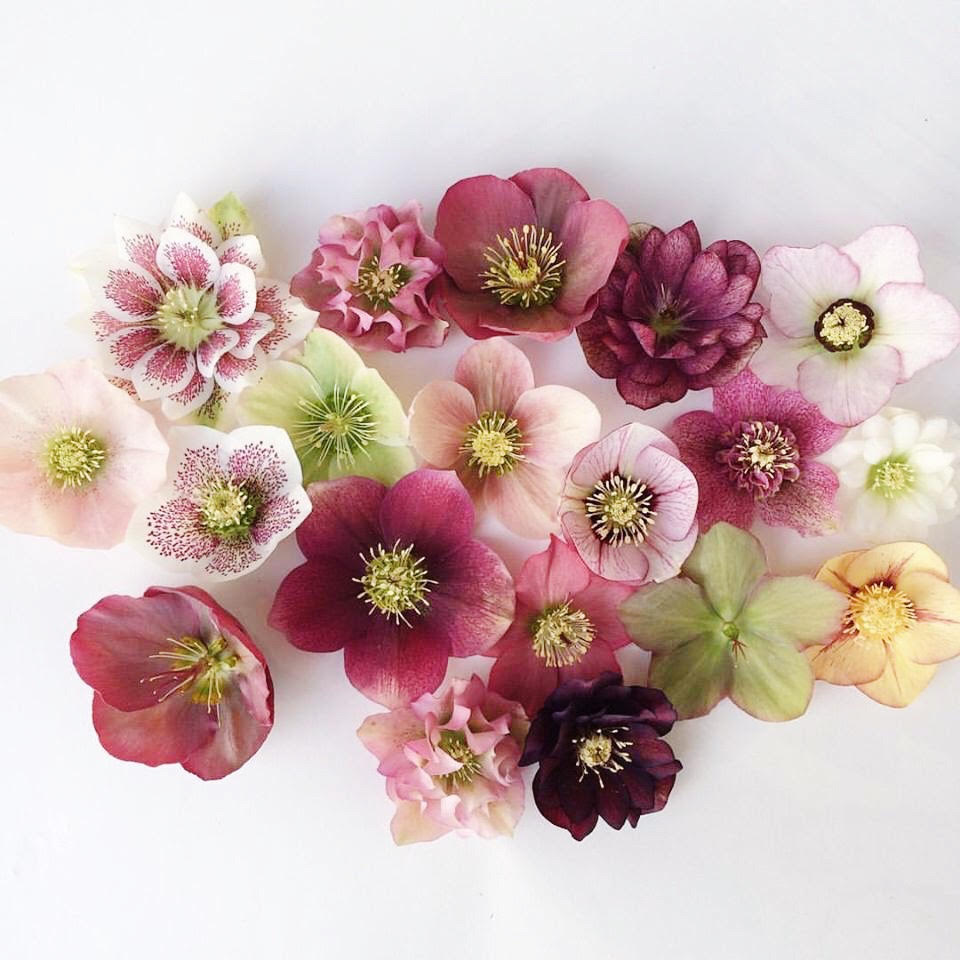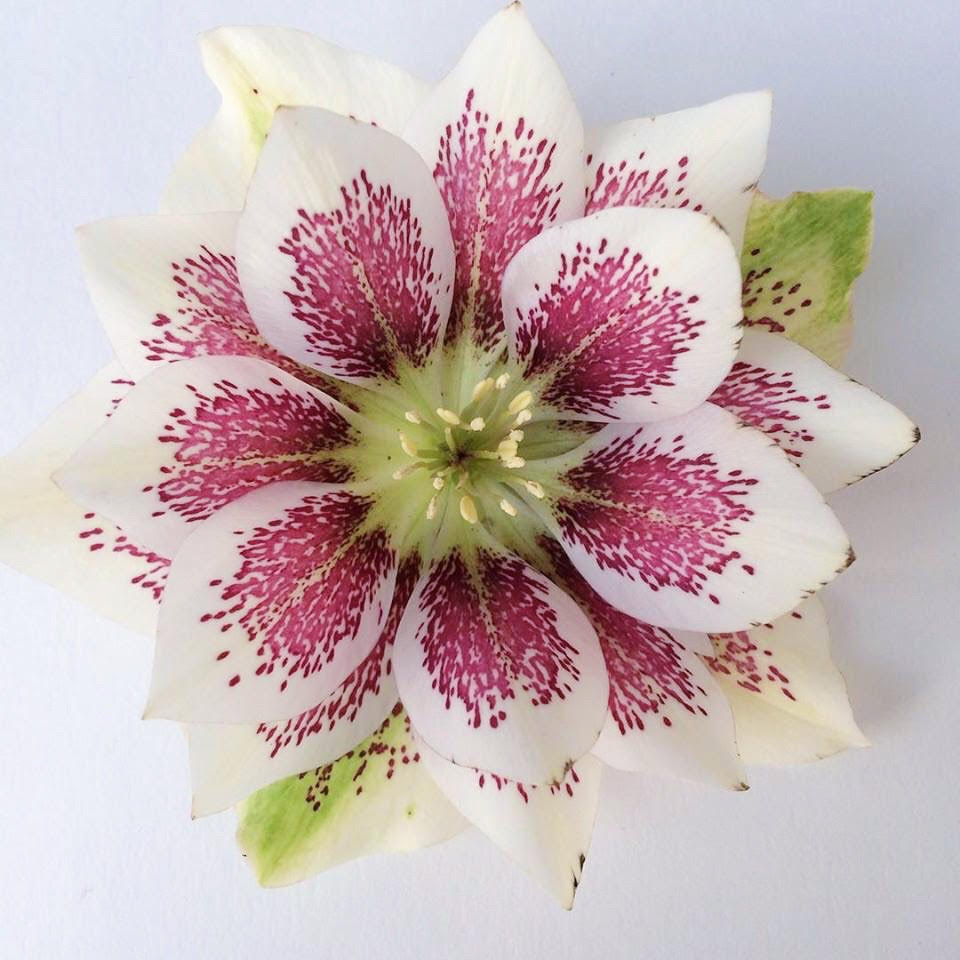There are only a couple of things that get me through the last days of winter – insta-stalking Aussie gardeners and winter-blooming hellebores.
This year, my hellebores started blooming in January (or maybe it was even late December with this bonkers weather?), got buried by snow, lived under the ice until the illustrious New England February blizzards err…rains set in, and now in a state of total confusion are trying to decide if they should give up or throw out flurry of new blooms. They are bedraggled midgets only notable to the chipmunks who decided to take the year off from hibernating and instead move into a cozy cavern they discovered beneath the floorboards of my office.
Meanwhile, my Pacific Northwest friends are toying with me – posting stuff like this…

At first I thought, ok Alicia, (I’m totally jealous) but so what? I mean, everyone knows that west coast people always get much better cut flowers than we easterners do… and besides you are a pro – so of course you know where to buy the best beauties.
But then I read the caption… um, she didn’t buy these… SHE GREW THEM — IN HER OWN GARDEN!
Stop the snow plows! I needed to get to the bottom of this:
Me: How many different types of hellebores do you grow?
Alicia: I took a head count this week and realized I’m up to 28 plants. I’d say I have about 20 different colors. I really, really love the doubles and am always looking to add more of those!
Me: How long have you been growing them? (’cause obviously forever, right?)
We bought our house two years ago, March 2014. I bought my first plant that first month and started out slowly, buying plants one at a time. The typical price tag of $15-20 per plant does help me to make a conscious choice when buying each plant. (umm…is she serious?)
 Me: What are your favorites?
Me: What are your favorites?
Alicia: Favorites are any of the doubles, and in particular my dark, dark plum-almost black double, can’t remember its name. Love Sparkling Diamond and really want more of these plants, but I find them difficult to find. My newest plant is a Double Painted which has lots of petals!
 Me: Do you have a special area for them? What do you grow with them? How are they in your garden? Seriously! How the he double hockey sticks do you pull this off?
Me: Do you have a special area for them? What do you grow with them? How are they in your garden? Seriously! How the he double hockey sticks do you pull this off?
Alicia: I live in Washington state, so must admit that they are very easy to grow here. I keep some of them in the flower bed in front of our house which does get the afternoon sun. They stay safe from the sun during the summer though because I fill the bed with my dahlia collection. (If you think I have a lot of hellebores, you should see the dahlia collection) (Yes, for sure, we will have to talk Dahlias when Dahlia season comes). My husband and I are going to start a flower bed for the hellebores, hydrangeas and astilbe on the northwest side of our house – it should be the perfect growing location.
Me: Where do you get your plants?
Alicia: It all started with a plant from Home Depot! Now I like to look at all the speciality nurseries and see what special ones they have in – again always looking for the killer dark plum double petal variety! A friend of mine, Riz Reyes of RHR Horticulture, recently took me to a wholesale nursery which has 5 greenhouses filled with hellebores – there’s a lot of digging and searching involved to find the perfect ones. Last time I added 5 plants to my collection! (I do own a business so I can go to the wholesale greenhouses.)
 Me: Any growing tricks/advice?
Me: Any growing tricks/advice?
Alicia: I find them to be rather easy to grow, but there are a few things to note. They like to be shaded during summer months and will need a good drink of water on hot days. I keep some of them in a flower bed that can get hot on a summer afternoon, the key is to plant taller plants around them so they get some rest during the hot season. I watch their leaves for any wilting and give them a good drink in the evening.
Me: Can you share some tips for cutting them? (in case you don’t know Alicia – she runs Flirty Fleurs – a trade focussed website and magazine for florists)
Alicia: When arranging at home I clip them low to the ground to get the longest stem possible. They last just fine for me in clean water, no floral foam. Now, I will be using them for an upcoming floral design class and I do plan to cut them and dip them in Quick Dip. (Instant Hydration Pretreatment for Fresh Flowers) The key is to not cut them too early in their lifespan, let the stamens fall off – right before they start to go to seed is the perfect time to cut them.
Me: Do you have any special tricks for growing them in a way that makes them useful for cut flower arrangements (mine hardly have stems! – Barely’s 6″ tall, they are so short, they seem to pick up a lot of dirt from the ground and would be near impossible to arrange).
Alicia: As the plant ages and gets more rooted the longer the stems will get. Plus, I do pick out plants that look to have longer, stronger stems since I know I’ll be using them in flower arrangements.
Me: What is your favorite way to arrange them/ display them?
Alicia: Well, there is always the simple, yet pretty way which is a beautiful glass bowl to float the blossoms in. My other favorite way is to make a centerpiece in a compote style vessel, and set them with pieris japonica and blooming branches. Clean, beautiful lines can be created with this mix!
 Me: Are there other things in your (clearly awesome) garden that you like to harvest at the same time to use in an arrangement?
Me: Are there other things in your (clearly awesome) garden that you like to harvest at the same time to use in an arrangement?
Alicia: Right now the only other bits I would use in my garden is Pieris Japonica, I have some pretty pink ones! Camellia leaves, too. I wish I had blooming branches to use from my own garden, maybe next year?! We also have lots of daffodils and crocus blooming, but those don’t go so well with hellebores!
Me: So there you have it – clearly hellebores are not that hard…if you live in the right place.
But for those of us who live in New England, my friend Matt (who seemingly knows everything about every plant) says that we can accomplish this too. I must however pick a plot and lime the heck out of my highly acidic soil (because despite the advertisements that they grow anywhere, they do prefer something either pH neutral or even slightly basic). Also, he advises that I need to invest in finding varieties other than the ubiquitous ‘holiday hellebores’ sold at Home Depot and the like (unlike in Washington State, HD in Leominster, MA does not carry a clever selection).
I have to admit, a least a couple of my plants are holiday gift/decorations tossed into the garden (they live and even seem to thrive as a ground cover but are no good for cutting). So I’m all over the Plant Delights website right now and I’ve identified the bed that will be beefed up with a collection. I’m hoping in couple years I too will be able to awe and amaze on instagram.

P.S. If you are in WA – you might check out Alicia’s upcoming class Hail to the Hellebore – where you learn to arrange with the flowers that she grows.
images provided by Alicia Schwede of Flirty Fleurs
+comments+